Object recognition memory and BDNF expression are reduced in young TgCRND8 mice
- PMID: 20447730
- PMCID: PMC3411544
- DOI: 10.1016/j.neurobiolaging.2010.04.003
Object recognition memory and BDNF expression are reduced in young TgCRND8 mice
Abstract
The TgCRND8 mouse model of Alzheimer's disease exhibits progressive cortical and hippocampal β-amyloid accumulation, resulting in plaque pathology and spatial memory impairment by 3 months of age. We tested whether TgCRND8 cognitive function is disrupted prior to the appearance of macroscopic plaques in an object recognition task. We found profound deficits in 8-week-old mice. Animals this age were not impaired on the Morris water maze task. TgCRND8 and littermate controls did not differ in their duration of object exploration or optokinetic responses. Thus, visual and motor dysfunction did not confound the phenotype. Object memory deficits point to the frontal cortex and hippocampus as early targets of functional disruption. Indeed, we observed altered levels of brain-derived neurotrophic factor (BDNF) messenger ribonucleic acid (mRNA) in these brain regions of preplaque TgCRND8 mice. Our findings suggest that object recognition provides an early index of cognitive impairment associated with amyloid exposure and reduced brain-derived neurotrophic factor expression in the TgCRND8 mouse.
Copyright © 2012 Elsevier Inc. All rights reserved.
Conflict of interest statement
The authors of this manuscript have no conflicts of interest to disclose.
All experiments conducted with mice were carried out according to the Canadian Council on Animal Care guidelines and were approved by the Animal Care Committee at the University of Toronto.
Figures
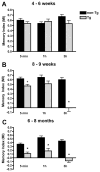
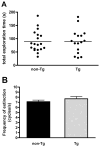
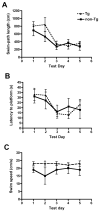
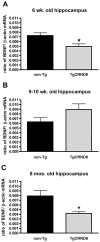
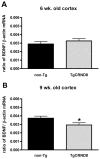
Similar articles
-
Selective cognitive deficits and reduced hippocampal brain-derived neurotrophic factor mRNA expression in small-conductance calcium-activated K+ channel deficient mice.Neuroscience. 2009 Sep 29;163(1):73-81. doi: 10.1016/j.neuroscience.2009.05.062. Epub 2009 May 29. Neuroscience. 2009. PMID: 19482064
-
Reduced tissue levels of noradrenaline are associated with behavioral phenotypes of the TgCRND8 mouse model of Alzheimer's disease.Neuropsychopharmacology. 2012 Jul;37(8):1934-44. doi: 10.1038/npp.2012.40. Epub 2012 Apr 11. Neuropsychopharmacology. 2012. PMID: 22491352 Free PMC article.
-
Amyloid beta and impairment in multiple memory systems in older transgenic APP TgCRND8 mice.Genes Brain Behav. 2009 Oct;8(7):676-84. doi: 10.1111/j.1601-183X.2009.00510.x. Epub 2009 May 26. Genes Brain Behav. 2009. PMID: 19531156
-
The effects of voluntary running on cerebrovascular morphology and spatial short-term memory in a mouse model of amyloidosis.Neuroimage. 2020 Nov 15;222:117269. doi: 10.1016/j.neuroimage.2020.117269. Epub 2020 Aug 18. Neuroimage. 2020. PMID: 32818618
-
Involvement of hippocampal agmatine in β1-42 amyloid induced memory impairment, neuroinflammation and BDNF signaling disruption in mice.Neurotoxicology. 2020 Sep;80:1-11. doi: 10.1016/j.neuro.2020.06.002. Epub 2020 Jun 6. Neurotoxicology. 2020. PMID: 32522471
Cited by
-
Early onset of hypersynchronous network activity and expression of a marker of chronic seizures in the Tg2576 mouse model of Alzheimer's disease.PLoS One. 2015 Mar 13;10(3):e0119910. doi: 10.1371/journal.pone.0119910. eCollection 2015. PLoS One. 2015. PMID: 25768013 Free PMC article.
-
The polyphenol oleuropein aglycone protects TgCRND8 mice against Aß plaque pathology.PLoS One. 2013 Aug 8;8(8):e71702. doi: 10.1371/journal.pone.0071702. eCollection 2013. PLoS One. 2013. PMID: 23951225 Free PMC article.
-
Rapamycin and interleukin-1β impair brain-derived neurotrophic factor-dependent neuron survival by modulating autophagy.J Biol Chem. 2014 Jul 25;289(30):20615-29. doi: 10.1074/jbc.M114.568659. J Biol Chem. 2014. PMID: 24917666 Free PMC article.
-
False recognition in a mouse model of Alzheimer's disease: rescue with sensory restriction and memantine.Brain. 2012 Jul;135(Pt 7):2103-14. doi: 10.1093/brain/aws074. Epub 2012 Mar 30. Brain. 2012. PMID: 22466291 Free PMC article.
-
Impaired Cholinergic Excitation of Prefrontal Attention Circuitry in the TgCRND8 Model of Alzheimer's Disease.J Neurosci. 2015 Sep 16;35(37):12779-91. doi: 10.1523/JNEUROSCI.4501-14.2015. J Neurosci. 2015. PMID: 26377466 Free PMC article.
References
-
- Ambree O, Touma C, Gortz N, Keyvani K, Paulus W, Palme R, Sachser N. Activity changes and marked stereotypic behaviour precede Aβ pathology in TgCRND8 Alzheimer mice. Neurobiol Aging. 2006;27:955–964. - PubMed
-
- Arvanitis DN, Ducatenzeiler A, Ou JN, Grodstein E, Andrews SD, Trendulkar SR, Ribeiro-da-Silva A, Szyf M, Cuello AC. High intracellular concentrations of amyloid-beta block nuclear translocation of phosphorylated CREB. J Neurochem. 2007;103:216–228. - PubMed
-
- Bellucci A, Luccarini I, Scali C, Prosperi C, Giovannini MG, Pepeu G, Casamenti F. Cholinergic dysfunction, neuronal damage and axonal loss in TgCRND8 mice. Neurobiol Dis. 2006;23:260–272. - PubMed
-
- Bellucci A, Rosi MC, Grossi C, Fiorentini A, Luccarini I, Casamenti F. Abnormal processing of tau in the brain of aged TgCRND8 mice. Neurobiol Dis. 2007;27:328–338. - PubMed
Publication types
MeSH terms
Substances
Grants and funding
LinkOut - more resources
Full Text Sources
Medical
Molecular Biology Databases

